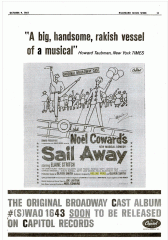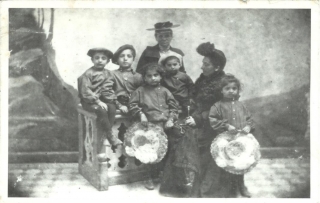1928 THE THEATRE GUILD. Designer Lee Simonson, member of the Guild, firmly believed that the vision of painters and designers could ‘revivify’ the theatre. George Pons’s experience in the Moscow Art Theatre and HP’s artistic background fit in perfectly with the Theatre Guild’s ambitious projects to create an art theatre on Broadway.
- Right You Are if you Think You Are – Luigi Pirandello
- Marco Millions – Eugene O’Neill
- Faust – Christopher Marlowe
1928. Using a then-revolutionary process, the costumes for Macbeth are entirely made of cotton and dyed and painted in the dyeing plant George Pons installed in the studio.
1931 Helene Pons receives a patent for a brassiere design that incorporated an “open-ended wire loop” that laid flat against the chest, encircling the bottom and sides of each breast.
1931 HP makes costumes for two Camilles in the same year: Eva Le Gallienne and Jane Cowl
1931 Begins collaboration with Guthrie McClintic-Katharine Cornell: The Barretts of Wimpole Street,Lucrece (1932), Alien Corn (1933), Romeo and Juliet (1934)
1933 MODERN DRESS. Producers often think that costuming a modern-dress play is a cinch and they balk at having to pay a designer from the Scenic Artists’ Union when they could easily (and more cheaply) send their wives off to Bergdorf Goodman of Saks Fifth Avenue to buy the clothes. In 1933 HP had been engaged by Robert Rockmore to design the costumes for Run Little Chillun. Rockmore insisted that his wife, theremin player Clara Rockmore, accompany her to shop for costumes. HP was furious, as was also Clara Rockmore, who had other things to do. The two women set off, having decided to detest each other, but once they discovered their Russian origin, they immediately became intimate friends and HP eventually designed extraordinary flame-colored jersey gowns for her concerts at the Lewisson Stadium that were praised even by the music critics.
1935 HP designs her first musical for the Theatre Guild: Porgy and Bess
1936. HP designs Babes in Arms using pastel colors for men’s clothes for the first time on Broadway. HP comes into contact with fellow Georgian, George Balanchine. She will make the costumes for many of his ballets. She creates the ‘rehearsal skirt’ to accustom dancers to the costumes they will wear during performances. She perfects the art of making tutus.
1937. The Eternal Road – oratorio-opera presented by Meyer Weisgal with music by Kurt Weill, book by Franz Werfel. Costumes designed by Norman Bel Geddes were made of unbleached muslin dyed in the studio. There was permanent chaos in the production of this megashow for lack of funds and logistic difficulties with the Manhattan Opera House: during the drilling to enlarge the orchestra pit, an underground stream surfaced flooding the theatre. All rehearsals were stopped until the money was found to solve the problem. The 250 members of the chorus were mostly refugees just arrived from Nazi Europe who did not speak English. Problems ensued with chorus who did not know how to wear the biblical costumes: girls would appear with blue ribbons in their hair, the men wore trousers under their tunics which showed when they were going up and down the stairs on stage. Costumes for Egyptian slaves were devised for men, but at the last moment Reinhardt decided they were to be women instead. Unfortunately there were no tops to the costumes and the girls appeared in their pink bras! HP insisted on having a dress parade in order to ‘train’ the cast to wear the costumes correctly.
1938. Our Town. Jed Harris commissioned HP to design the costumes for Thornton Wilder’s masterpiece set between 1901 and 1913 in a New England town. She devised costumes as she remembered her family for the timeless atmosphere of the play.
1938 THE PLAYWRIGHT’S COMPANY.
- Knickerbocker Holiday – play: Maxwell Anderson, music: Kurt Weill
- American Landscape
- Outward Bound
1941. THE “APRON SAGA” Helene made the costumes, designed by Aline Bernstein, for Harriet. She created some delightful aprons for the leading ladies, and one day Laura Newton, buyer for Bloomingdales came to the studio to ask her to reproduce those aprons for the department store. “How many do you want” she asked. “About one hundred dozen” replied Laura. As World War II had just broken out, life had changed dramatically: housewives were now fending on their own without maids or cooks who had gone to work in munitions plants. Traditionally aprons were banal, squalid. HP’s creations, instead, were elegant, extremely fashionable. As it was difficult to find fabrics due to the War Effort, she used upholstery material instead. Soon buyers from all over the country were flocking to the studio to order her aprons. Lord & Taylor in New York featured them in its Fifth Avenue windows. The apron “saga” caused an uproar in the studio. Her secretary quit, her husband insisted she was insane to even contemplate being a manufacturer, her workers, accustomed to making unique costumes for the theatre, felt humiliated and bored at the idea of mass production. There were also problems with the Union. She finally accepted the offer from City of Paris in San Francisco to open a branch in San Matteo where she could create clothes for the Helene Pons Department in that department store. Theatrical business had slowed down because of the war and it seemed a good idea to leave George to run the studio in New York and to start a new business in California.
1947. Back in New York, HP makes costumes designed by Aline Bernstein for The Eagle Has Two Heads with Tallulah Bankhead, followed by Crime and Punishment with John Geilgud and Medea with Judith Anderson.
1949. Kiss Me Kate. Lack of funds was a blessing in disguise: Renaissance costumes were made of simple dyed cotton. No velvet, no gold braiding. No spangles. Only extraordinary combination of colors.
1950. THE METROPOLITAN OPERA. 1950. When Rudolf Bing became director of the Metropolitan Opera, he brought about great changes. The first “new” opera was Aida with costumes designed by Rolf Gerard. Mario Del Monaco was making his American debut. The new production of Aida was superb.
1955. Diary of Anna Frank. To give the impression that Anna was outgrowing her clothes, a set of identical costumes were made smaller and smaller for the different acts to illustrate the passing of time.
1956. My Fair Lady. After Cecil Beaton handed HP the beautiful sketches of the costumes with no hint of details, he left for Japan and retuned just in time for the dress parade. Fortunately he liked the costumes.


